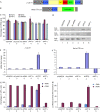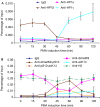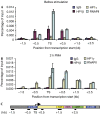Regulation of an inducible promoter by an HP1beta-HP1gamma switch
- PMID: 18239689
- PMCID: PMC2267390
- DOI: 10.1038/embor.2008.1
Regulation of an inducible promoter by an HP1beta-HP1gamma switch
Abstract
The mammalian heterochromatin protein 1 (HP1) family of proteins was recently shown to be involved in transient repression of inducible promoters. One of these promoters is the HIV1 long terminal repeat, which, during viral latency, recruits a non-processive RNA polymerase II (RNAPII) that synthesizes a short regulatory transcript. Here, we have used this promoter to examine the interplay of HP1alpha, HP1beta and HP1gamma with RNAPII. We find that, in the absence of stimulation, HP1beta is present on the promoter together with the non-processive RNAPII and functions as a negative regulator. On activation, HP1beta bound to methylated H3K9 is rapidly released concurrent with histone H3 phospho-acetylation, and is replaced by HP1gamma. This isoform localizes to the promoter but also inside the coding region, together with the processive RNAPII. Our data show that HP1 recruitment-release is a sequential mechanism that is precisely regulated and highly dependent on transcription.
Conflict of interest statement
The authors declare that they have no conflict of interest.
Figures




Similar articles
-
Mammalian HP1 Isoforms Have Specific Roles in Heterochromatin Structure and Organization.Cell Rep. 2017 Nov 21;21(8):2048-2057. doi: 10.1016/j.celrep.2017.10.092. Cell Rep. 2017. PMID: 29166597
-
Differential cooperation between heterochromatin protein HP1 isoforms and MyoD in myoblasts.J Biol Chem. 2008 Aug 29;283(35):23692-700. doi: 10.1074/jbc.M802647200. Epub 2008 Jul 2. J Biol Chem. 2008. PMID: 18599480 Free PMC article.
-
DNA Damage Changes Distribution Pattern and Levels of HP1 Protein Isoforms in the Nucleolus and Increases Phosphorylation of HP1β-Ser88.Cells. 2019 Sep 17;8(9):1097. doi: 10.3390/cells8091097. Cells. 2019. PMID: 31533340 Free PMC article.
-
Regulation of HIV-1 transcription.Gene Expr. 1999;8(2):67-84. Gene Expr. 1999. PMID: 10551796 Free PMC article. Review.
-
Function of heterochromatin protein 1 during DNA repair.Protoplasma. 2017 May;254(3):1233-1240. doi: 10.1007/s00709-017-1090-3. Epub 2017 Feb 24. Protoplasma. 2017. PMID: 28236007 Review.
Cited by
-
Histone H3 lysine 9 trimethylation and HP1γ favor inclusion of alternative exons.Nat Struct Mol Biol. 2011 Mar;18(3):337-44. doi: 10.1038/nsmb.1995. Epub 2011 Feb 27. Nat Struct Mol Biol. 2011. PMID: 21358630
-
Epigenetic silencing of human immunodeficiency virus (HIV) transcription by formation of restrictive chromatin structures at the viral long terminal repeat drives the progressive entry of HIV into latency.J Virol. 2008 Dec;82(24):12291-303. doi: 10.1128/JVI.01383-08. Epub 2008 Oct 1. J Virol. 2008. PMID: 18829756 Free PMC article.
-
Shigella flexneri targets the HP1γ subcode through the phosphothreonine lyase OspF.EMBO J. 2014 Nov 18;33(22):2606-22. doi: 10.15252/embj.201489244. Epub 2014 Sep 12. EMBO J. 2014. PMID: 25216677 Free PMC article.
-
Heterochromatin protein 1 is recruited to various types of DNA damage.J Cell Biol. 2009 May 18;185(4):577-86. doi: 10.1083/jcb.200810035. J Cell Biol. 2009. PMID: 19451271 Free PMC article.
-
PADI4-mediated citrullination of histone H3 stimulates HIV-1 transcription.Nat Commun. 2025 Jun 25;16(1):5393. doi: 10.1038/s41467-025-61029-0. Nat Commun. 2025. PMID: 40562767 Free PMC article.
References
-
- Anest V, Hanson JL, Cogswell PC, Steinbrecher KA, Strahl BD, Baldwin AS (2003) A nucleosomal function for IκB kinase-α in NF-κB-dependent gene expression. Nature 423: 659–663 - PubMed
-
- Batsché E, Yaniv M, Muchardt C (2006) The human SWI/SNF subunit Brm is a regulator of alternative splicing. Nat Struct Mol Biol 13: 22–29 - PubMed
-
- Clayton AL, Mahadevan LC (2003) MAP kinase-mediated phosphoacetylation of histone H3 and inducible gene regulation. FEBS Lett 546: 51–58 - PubMed
-
- Daujat S, Zeissler U, Waldmann T, Happel N, Schneider R (2005) HP1 binds specifically to Lys 26-methylated histone H1.4, whereas simultaneous Ser 27 phosphorylation blocks HP1 binding. J Biol Chem 280: 38090–38095 - PubMed
Publication types
MeSH terms
Substances
LinkOut - more resources
Full Text Sources
Research Materials
Miscellaneous

